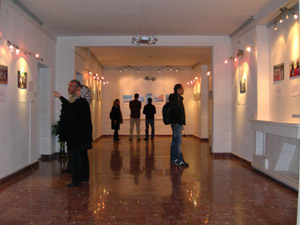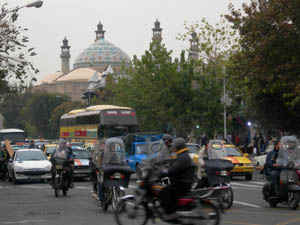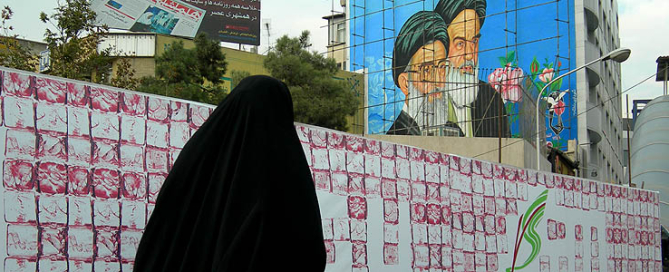November 14, 2008
Km 68,040
Finally, after several difficult days on the road, I arrived to Tehran; and there, everything was easier. Maybe because people are getting more open minded, more educated or simply because I was not the only tourist on the roads.
Tehran is a huge city, with 15 million inhabitants, but it is not difficult to see who with a map of the city ask information, or who lost is accompanied and guided by the first person which is around. Few minutes of walking among its streets are enough to discover the people’s availability and their warmth; and to understand that it is not the Iran that we watch on TV.
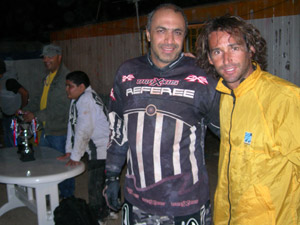
To my arrival I was received by Reza, who I had contacted through couchsurfing.com, an internet site about travellers and their desires of knowing people from everywhere. Reza had been part of the Paintball team which have been world champion in 2004, and now because of he is part of the committee of referees of that sport, he invited me to attend a competition in which I had the honour of giving the third prize. There, during the whole afternoon his friends assisted me like a friend. I also was several days in Karim house, where he and his father assisted me as in a hotel. I remember one day when I went to a bar and his owner after knowing from where I am, didn’t accept that I pay my bill. Tehranian people really were so generous with me; they never stopped to treat me well.
The city has a cosmopolitan air, where diverse ethnic and linguistic groups from the whole country live. Most of the inhabitants are Shiite and the minority Sunnite, Zoroastrians, Jewish and Christian. Small Hindu groups, Buddhists, atheists and followers of the Sufism also exist.
During my stay in Tehran I was interested about Iran history and its topical issues, for it, between books and chats I was learning a little about the country where I was. According to explained me, in the year 550 B.C., Cyrus II the Great, under the Achaemenid dynasty unified the Persian people and he conquered Babylon, Syria, Palestine and Asia Minor. But his successors were who did the Persian Empire the largest well-known empire until then, in the Near East. Dario I, was who reached its maximum splendour, opening roads and building palaces and monuments in the capital cities: Susa and Persepolis, which today are some of the main tourist points to visit in Iran. He also transformed the Zoroastrianism as the official religion. The Zoroastrianism or Mazdaism is one of the first monotheistic religions, the sacred book is the Avesta; this religion still exists in Iran and it is one of the officially admitted religions, although the majority religion is the Islam. There are Zoroastrians followers in India and other countries too. They believe in a unique God “Ahura Mazda”. The base of this religion is “pendare nik, goftare nik, kerdare nik” that means: “to think well, to speak well, to make well”.
The Persian Empire culminated with Great Alejandro’s invasion in 336 to. C.
During the following century Persia was under rule of different people but in the middle of the VII century the Arabs arrived and with them, the introduction of the Islam. Then different dynasties stayed on the power during the following 5 centuries. In 1220 Persia was conquered by the Mongolian of Genghis Khan, until at the beginning of the XVI century Persia reached its Independence, with the Safavida Dynasty, who created the biggest Empire from the Muslim conquest. Then different dynasties follow it with their respective Shah or emperor.
The history of oil
Reza is the director of a software company which renders services to companies related to the oil industry. In the wall of his office there is a big map with all the oil and gas locations. For it, to talk with him was fascinating. “Iran is the world’s third largest oil reserves”, he told me, “and the second in gas”. “So, it is not difficult to understand the real interest from the different colonies that started to arrive 150 years ago”.
At the end of the XIX century, when it was understood that the oil would replace to the coal like the main source of energy of the XX century, Persia next to Middle East became the target of a handful of anxious western powers of controlling the region and its resources, and to prevent its rivals to make the same thing. In that time Iran was a backward and feudal society. Most of the population lived in the farms and worked the land. There was a variety of tribes united by the religion and a monarchy. The king’s will was absolute.
This way, Persia was a focal point of a lingering fight between Russia and England for the political and economic control, while at the same time they modernized the country.
In that time Great Britain didn’t have access first-hand to the oil and they depended on USA, Russia or Mexico for its supplies. For it, through the geologist and engineer William D’Arcy, Great Britain could secure oil rights of inspection in the lands of the Persian Shah Muzaffar al-Din.
In 1901 D’Arcy obtained a concession of 500,000 square miles (almost 85% of what today is Iran) for 60 years. It gave him the exclusive right of exploiting the oil for a payment to the government of 20,000 pounds sterling, 20,000 pounds in stocks and 16% of the earnings. By this way in collaboration with the English Government, D’Arcy established the Anglo-Persian Oil Company (that later became Anglo-Iranian Oil and then British Petroleum). In that time the procedure to continue in the countries where the deposit of oil were discovered, consisted in that a delegation interviewed with the king or shah who in general ignored what it was or for what reason the oil did serve, and then by means of a payment, usually in currencies of gold or silver or a small percentage was gotten the concession. These concessions were a permission to extract, to treat and to transport the crude.
After World War II, AIOC (Anglo-Iranian Oil Company) and the Iranian government initially resisted nationalist pressure to revise AIOC’s concession terms still further in Iran’s favour. In 1951, the pro-western Prime Minister Ali Razmara was assassinated. The Iranian Parliament elected a nationalist, Mohammed Mossadeq, as Prime Minister. Months later, the parliament nationalized the oil industry and the Shah, Mohammad Pahlevi is pushed to the exile. The British government decided that the only way to regain its control of Iranian oil was to remove Mossadeq from office. For it, with the support of United States, they overthrew the Iranian government. The CIA and MI6 (Agency of external Intelligence of the United Kingdom) conspiracy became known by its codename operation Ajax.
On August 19, 1953, Mossadeq was forced to leave office through a military coup. He was replaced by pro-Western general Fazlollah Zahedi. So, the AIOC became The British Petroleum Company in 1954, and resumed operations in Iran. However, it was not allowed to monopolise Iranian oil as before. It was limited to a new international consortium. On the other hand, the Shah Mohammad Reza Pahlevi recovered the throne and he becomes one of the big western allies in the region, he rules with iron hand supported by the United States military help and by a powerful police, the SAVAK. He suppresses the political parties and a politics of modernization of the country undertakes; he also undertakes agricultural reforms, nationalizes natural resources and extends the vote to the women. He also leans towards the laicism and towards the recognition of Israel.
The Iranian revolution of 1979
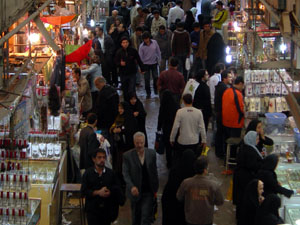
The Shah reforms were not success; the big part of the population becomes poor more and more, while the dominant oligarchy gets rich. But all rebellion intent was suffocated by the authority of the Shah, and the SAVAK which was in charge of watching over and repressing the civil population’s activities related against the Shah and the dictatorship. The Savak is accused by the disappearances and tortures during the reign of the Shah. So, the dissatisfaction is taken advantage by the clergy Shiite which has the support of the population’s 80% and who criticizes the loss of the morals and the Islamic values, and the interference of the western powers.
The revolution arises in Qom, a religious city 150 km far south of Teheran, from where Ayatollah Jomeini, its religious leader, was native. People went to protest to the square of the town and the police opened fire against the multitude. The result was hundreds of dead. This caused protests in the whole country and more deaths. There were moments in which Iranian soldiers refused to open fire on the workers and peasants and they aimed their rifles against the dominant class. The atmosphere became too tense and for it the Shah escaped and exiled in Egypt.
On February 1 1979, Ayatollah Jomeini, who was exiled in France, returned. Under his command, the Islamises are able at once to be in charge of the revolution and to repress to the other groups. On March 31 are made a referendum and the clergy option is supported, according to the official data, per the population’s 98% and Iran becomes an Islamic Republic.
The relationships with the United States became tragic when students from Iran entered and captured 52 people of its embassy and they classified them like spies and bound up with the CIA, and for it they took them as hostages. Only 14 months later they were liberated. The masses screamed: “Death to the USA imperialism” and they burned the USA flags.
But for many people the revolution was not a success; because the power passed to the hands of the Iranian labour class and this didn’t know what to do and neither had it anybody who explained it. On this way Jomeini became the leader who found his nearest religious allies in the government’s key positions. And together, they crush the independent movement of the labour class using the backwards and ignorant layers of the society to settle in the power. So the liberal party and the Left were attacked, and also their religious adversaries were repressed. In that year, more than 1.500 people had been executed under the regime of Jomeini. He also carried out a purge of all the elements “contrary to the Islamism” in the universities, in the media and in other cultural institutions. In a short time, many Iranians, especially those who didn’t share the religious fervour, were subjected to a political and cultural repressive regime. Many industries were also nationalized, among them the oil industry.
My last days in Tehran
In September, 1980, taking advantage of the reining chaos during the first months of the Revolution, the Iraqi president Saddam Hussein attacked Iran with the purpose to achieve some territorial earnings and to overthrow Jomeini. Iran that at the beginning was in an unfavourable situation in front of its rival, was able to revert its position since 1982 and for it, its religious leader proclaimed his determination of making arrive the revolution to the whole region. On this way the Arab governments from the area supported the idea of containing Iran and with the support of United States, they were able to support Iraq to stop the advance of Iran. The war Iraq – Iran lasted 8 years.
Today, nearly 30 years since the revolution, a walk through the streets is enough to notice the sequels that it left. In March, 1979 it was declared obligatory the use of the veil in the women. According to Jomeini, the woman should hide to the man, and even to the youths, her hair and her body. But at the present time many women show their dissatisfaction with the old measure, showing their hair as much as it is possible. What it does seem incredible is that a poster exists in many shops which says that women who don’t cover her hair like it is due will not be served. Of course that the shops or bars are forced to have such sign, “but it is very strange that it happens”, Mahdi said to me.
Mahdi also talked me about the nuclear energy and its necessity: “Iran is a country where the electricity is subsidized and maybe for it, is difficult to regulate its consumption. But currently we have to import energy from neighbouring countries”. “The nuclear energy is a population’s right and not from the governments”, he said to me. “The petrol is also subsidized in the country, but there is a limit: 120 monthly litres per car, the rest is paid to an international price. But the measure is taken by the excessive traffic in the cities and the lack of structure of the same ones.”
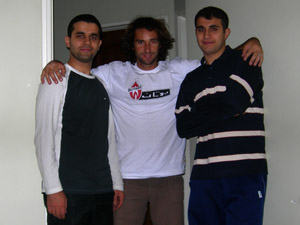

The last week of my stay Hadi hosted me, an university student who plans with a big desire to make his overseas master degree; and who very curious asked me about the western youth’s customs. Hadi was educated by a religious family, he uses to pray 5 times per day and he really is a healthy mind guy. His mother who didn’t speak English liked to talk with me about the Islam. One morning I had the privilege of being able to visit a Koran class, where there were only women who after knowing about my wish of entering, they covered themselves with their black blankets. They also allowed me to do some photos; something almost impossible for these latitudes. At the end of my stay, the Hadi mom who always covered herself with her blanket every time that she saw me presented me a CD with the Koran in Spanish. They really were a charming family, and different to the people than I use to mix.
During my stay I also visited the Argentinean Embassy, where I attended to a get-together and where I met Khalili, the director of Butane, one of the biggest companies, in the production of the liquefied petroleum gas in the country. Khalili who speaks Spanish very well at once was interested in the project that I am carrying out and for it he welcomed me with his family. And they really made me feel as if they were my distant relatives. He also offered me to be my Iranian sponsor and together with his wife they organized an exhibition of my photos in Nikzad Gallery. There, in the gallery I met to their relatives and friends, who also contributed buying my photos. My trip would be so easy, if in every country I would meet people like Khalili.
